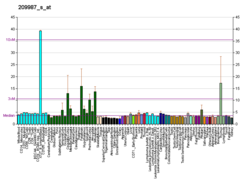Role in neuronal commitment
Development of the vertebrate nervous system begins when the neural tube forms in the early embryo. The neural tube eventually gives rise to the entire nervous system, but first neuroblasts must differentiate from the neuroepithelium of the tube. The neuroblasts are the cells that undergo mitotic division and produce neurons. [7] Asc is central to the differentiation of the neuroblasts and the lateral inhibition mechanism which inherently creates a safety net in the event of damage or death in these incredibly important cells. [7]
Differentiation of the neuroblast begins when the cells of the neural tube express Asc and thus upregulate the expression of Delta, a protein essential to the lateral inhibition pathway of neuronal commitment. [7] Delta, a membrane-bound protein, can then bind to the Notch receptor of neighbouring cells, which upon activation undergoes proteolytic cleavage to release the intracellular domain (Notch-ICD). [7] The Notch-ICD is then free to travel to the nucleus and form a complex with Suppressor of Hairless (SuH) and Mastermind. [7] This complex, by inducing the transcription of HES1, a transcriptional repressor, then represses the transcription of Asc and accomplishes two important tasks. First, it prevents the expression of factors required for differentiation of the cell into a neuroblast. [7] Secondly, it inhibits the neighboring cell's production of Delta. [7] Therefore, the future neuroblast will be the cell that has the greatest Asc activation in the vicinity and consequently the greatest Delta production that will inhibit the differentiation of neighboring cells. The select group of neuroblasts that then differentiate in the neural tube are thus replaceable because the neuroblast's ability to suppress differentiation of neighboring cells depends on its own ability to produce Asc. [7] This process of neuroblast differentiation via Asc is common to all animals. [7] Although this mechanism was initially studied in Drosophila, homologs to all proteins in the pathway have been found in vertebrates that have the same bHLH structure. [7]
This page is based on this
Wikipedia article Text is available under the
CC BY-SA 4.0 license; additional terms may apply.
Images, videos and audio are available under their respective licenses.






